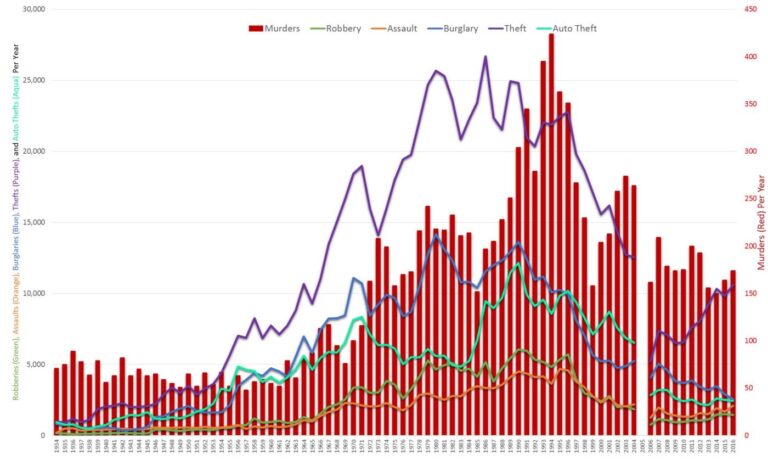As the United States approaches a milestone of record-low murder rates, New Orleans is reflecting this broader trend with notable declines in violent crime. Recent data indicate that the city, long known for its struggles with high homicide figures, is experiencing a downward shift in criminal activity. This development aligns with nationwide efforts and community initiatives aimed at improving public safety, marking a significant moment in the ongoing battle against violent crime across the country.
U.S. Sees Historic Decline in Murder Rates for First Half of 2024
Preliminary FBI data reveal a remarkable downturn in homicide rates across the United States, signaling one of the most significant crime reductions in recent history. Experts attribute this trend to a combination of strategic law enforcement initiatives, community engagement programs, and advancements in technology that have enhanced crime detection and prevention. Cities traditionally plagued by high murder rates are witnessing notable improvements, giving hope to communities long affected by violence.
New Orleans exemplifies this encouraging nationwide wave, reporting not only fewer homicides but also positive shifts in associated crime metrics. Key factors contributing to this decline include:
- Improved policing tactics focused on targeted intervention.
- Expanded social services addressing root causes of violence.
- Community policing efforts fostering trust between residents and law enforcement.
| City | Homicides (H1 2023) | Homicides (H1 2024) | % Change |
|---|---|---|---|
| New Orleans | 102 | 76 | -25.5% |
| Chicago | 209 | 160 | -23.4% |
| Los Angeles | 154 | 121 | -21.4% |
New Orleans Mirrors National Trend with Significant Drop in Violent Crime
Violent crime rates in New Orleans have shown a marked decline, aligning closely with the national trend where the U.S. is on course for one of its lowest murder rates in decades. This shift comes after years of fluctuating figures and represents a positive development for a city historically plagued by high crime. Experts attribute the drop to enhanced community policing efforts, improved social services, and targeted interventions in crime hotspots. Additionally, technology-driven strategies such as predictive analytics and increased surveillance have played a pivotal role in bolstering law enforcement responsiveness.
A closer look at the latest data reveals several key factors contributing to this downturn:
- Community Engagement: Neighborhood watch programs and local outreach initiatives have strengthened police-public relationships.
- Economic Investments: Job creation and educational funding aimed at at-risk populations are creating long-term solutions.
- Focused Enforcement: Resources concentrated in historically higher-risk districts have curbed violent incidents.
| Crime Category | 2022 Rate | 2023 Rate | % Change |
|---|---|---|---|
| Homicides | 150 | 110 | -27% |
| Aggravated Assaults | 580 | 480 | -17% |
| Robberies | 310 | 270 | -13% |
Analyzing Factors Behind the Decline in Homicides Across Major Cities
Multiple dynamics have contributed to the marked drop in homicide rates across major U.S. cities, including New Orleans. Analysts highlight targeted community policing efforts that foster trust between law enforcement and neighborhoods historically impacted by violence. Additionally, increased investments in social programs offer crucial support systems addressing root causes such as poverty and lack of educational opportunities. Technology also plays an underscored role, with predictive analytics enabling quicker intervention and resource allocation in high-risk areas.
- Enhanced collaboration: Local agencies working in tandem with federal programs
- Data-driven approaches: Leveraging crime data for proactive prevention
- Community engagement: Empowering residents through outreach and support groups
| City | Homicide Rate Reduction (2023 vs 2022) | Key Initiative |
|---|---|---|
| New Orleans | 15% | Neighborhood Patrol Expansion |
| Chicago | 12% | Youth Violence Prevention Programs |
| Los Angeles | 10% | Gun Violence Reduction Task Force |
Furthermore, policy reforms promoting stricter gun control measures and sentencing reforms have shifted the landscape. Economic revitalization projects targeting high-crime zones have also sparked job growth, which correlates with lower violent crime rates. While challenges remain, this multifaceted approach combining law enforcement modernization, social investment, and policy adjustments points toward sustainable homicide declines.
Policy Recommendations to Sustain and Enhance Crime Reduction Efforts
To maintain and build upon the impressive crime reduction momentum, it is essential to prioritize community-oriented policing strategies that emphasize trust and cooperation between law enforcement and residents. Investing in proactive engagement programs, such as neighborhood patrols and youth outreach, can deter criminal activity before it takes root. Additionally, allocating resources toward advanced data analytics will enable agencies to deploy officers more efficiently and address emerging crime hotspots dynamically. Policymakers should also work to strengthen support for mental health and addiction services, recognizing that addressing underlying social issues is key to sustained public safety improvement.
Key initiatives to consider:
- Expand community policing: Build stronger relationships to foster local cooperation.
- Enhance technology use: Implement predictive policing tools and real-time data monitoring.
- Increase socio-economic support: Focus on education, employment, and rehabilitation programs.
- Improve inter-agency collaboration: Share intelligence across jurisdictions for coordinated responses.
| Strategy | Expected Impact | Implementation Timeline |
|---|---|---|
| Community Outreach Programs | Higher community trust, reduced violent crime | 6-12 months |
| Data-Driven Policing | Enhanced resource allocation, faster crime response | 3-6 months |
| Mental Health Services Expansion | Reduced repeat offenses, better rehabilitation | 12-18 months |
The Conclusion
As the U.S. moves toward a historic low in murder rates, New Orleans reflects this encouraging national trend with its own notable declines in violent crime. While challenges remain, the city’s progress signals the potential for continued improvement in public safety. Ongoing efforts by law enforcement, community organizations, and local leaders will be critical in sustaining these positive developments and ensuring safer neighborhoods for all residents.




